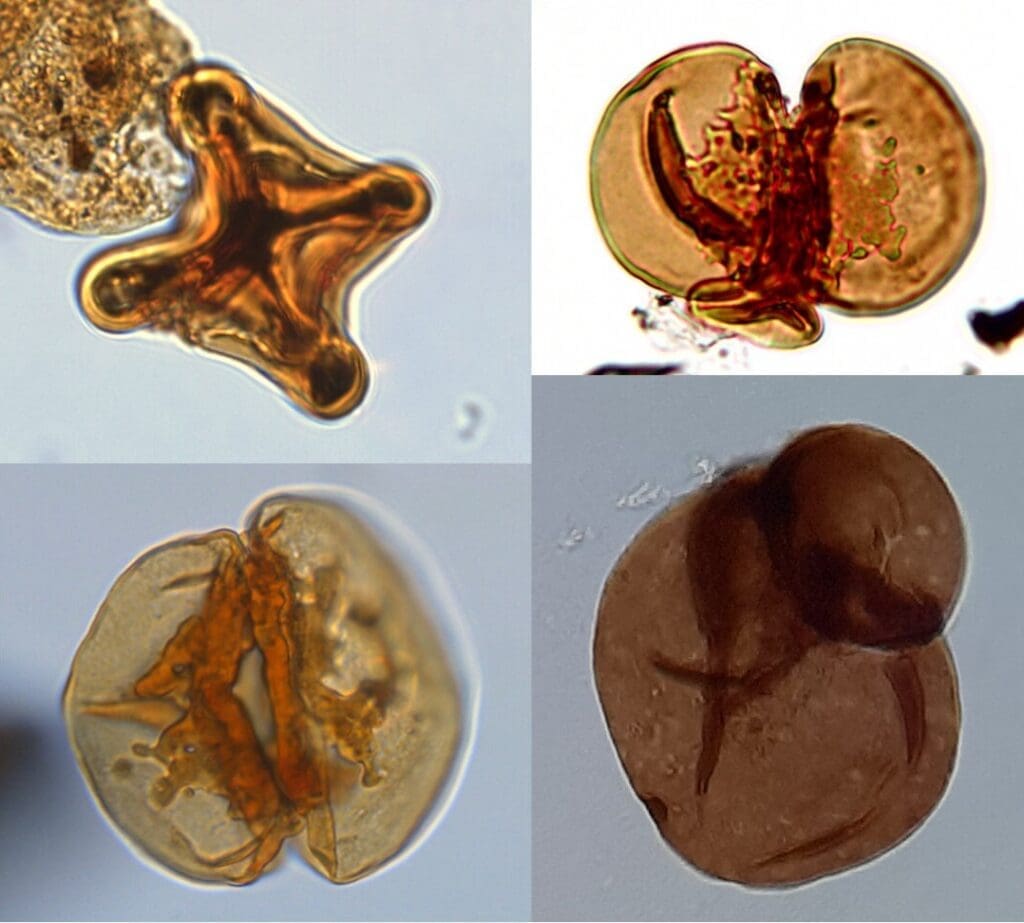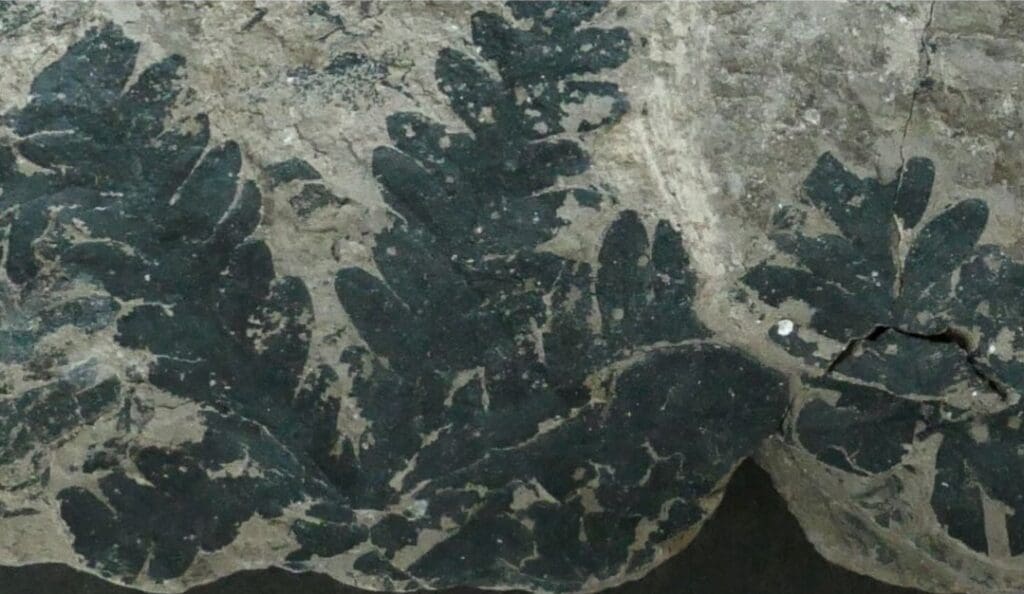The link between massive flood basalt volcanism and the end-Triassic (201 million years ago) mass-extinction is commonly accepted. However, exactly how volcanism led to the collapse of ecosystems and the extinction of entire families of organisms is difficult to establish. Extreme climate change from the release of carbon dioxide, degradation of the ozone layer due to the injection of damaging chemicals, and the emissions of toxic pollutants, are all seen as contributing factors. One toxic element stands out: mercury. As one of the most toxic elements on Earth, Hg is a metal that is emitted from volcanoes in gaseous form, and thus has the capacity to spread worldwide. A new study in Nature Communications adds new compelling evidence for the combined effects of global warming and widespread mercury pollution that continued to stress plants long after volcanic activity had ceased.
An international team of Dutch, Chinese, Danish, British, and Czech scientists studied sediments from Northern-Germany in a drill-core (Schandelah-1) that spans the uppermost Triassic to lower Jurassic for microfossils and geochemical signals. A study of pollen and spore abundances revealed a profusion of fern spores showing a range of malformations, from abnormalities in wall structure to evidence for botched meiotic divisions, leading to unseparated, dwarfed, and fused fern spores. “Seeing the sheer amount and different types of malformed fern spores in sediment samples from a coastal lagoon, dating back 201 million years ago is truly astonishing. It means there must have been very many ferns being stressed,” explains Remco Bos, a PhD candidate at Utrecht University and lead author of the study. “It is also not something we see regularly during other periods that also contain many fern fossils, making it a true signal connected to the end-Triassic mass-extinction event.”
Deforestation and ferns
The results from Bos and co-authors confirm earlier work by co-authors Sofie Lindström (University of Copenhagen), Hamed Sanei (Aarhus University), and Bas van de Schootbrugge (Utrecht University), who previously produced similar data obtained from cores from Denmark and from nearby outcrops in Sweden. According to Sofie Lindström: “Ferns replaced trees across the extinction interval in response to dramatic environmental changes likely driven by heat stress, strongly increased monsoonal rainfall, and increased forest fire activity. Palynological results show that a pioneering fern vegetation spread across vast swaths of coastal lowlands in Northwestern Europe from Sweden and Denmark to Germany, France, Luxemburg, and Austria in response to widespread deforestation.” Ferns are hardy plants, often colonizing disturbed environments, including newly formed volcanic islands or landscapes devastated by volcanism or wildfires. “What is extraordinary here is that the ferns that produced all these malformed spores in all these different sites, did not go extinct. While other plants went extinct, ferns were apparently robust enough to continue, which could also be related to their different mercury tolerance.”
“There must have been very many ferns being stressed“
– Remco Bos, Department of Earth Sciences

In this new study, Bos and co-authors show that the ferns, which took advantage of the dieback of forests, themselves were subjected to stress from Hg-pollution well beyond the immediate extinction interval. “We found four more intervals with high levels of Hg concentrations and high numbers of malformed spores in the 1.3 to 2 million years following the extinction interval,” explains Remco Bos. This interval, known as the Hettangian, was a time of continuing adverse conditions in the oceans, with generally low diversities among marine invertebrates, such as ammonites and bivalves. On land, however, vegetation appeared to have recovered quicker. “We now show that this forest ecosystem continued to be perturbed repeatedly for at least 1.3 million years, but perhaps as long as 2 million years,” Bos explains.
The four additional episodes of high Hg concentrations and high fern spore malformations were unlikely connected to later phases of Central Atlantic Magmatic Province volcanism. Instead, Bos and co-authors show that these periods correspond closely to the long eccentricity cycle, the major variation in the shape of Earth’s orbit that moves Earth closer or further away from the Sun every 405 thousand years. During eccentricity maxima Earth moves closer to the Sun allowing for more sunlight to reach the Earth surface. As the Earth’s atmosphere was already supercharged with carbon dioxide from the large-scale volcanism, this cyclic modulation of the climate system repeatedly triggered forest dieback, allowing for the renewed spread of pioneer ferns. As is shown by the correlation with high Hg contents, malformations in fern spores during these episodes were also the result of mercury poisoning. But where did this Hg come from?

Hg-isotopes
A crucial data set was generated at Tianjin University (China) by Wang Zheng, a co-corresponding author and geochemist specialized in metal isotope studies, especially Hg-isotopes. Mercury has different stable isotopes that behave differently in the environment. During reactions in nature, for example the expulsion from volcanism, deposition from the atmosphere, and the uptake by organisms, Hg-isotopes can become fractionated, enriching one pool in heavier isotopes, and others in lighter isotopes. Sediments with elevated levels of Hg and malformed spores also show clear variations in Hg-isotopes. “Based on the Hg-isotope variations we were able to link an initial pulse in Hg enrichment at the Triassic-Jurassic boundary to the emission of mercury from flood basalt volcanism,” Wang Zheng explains. “However, the four other pulses in mercury had a different isotopic composition, indicating they were mainly driven by Hg input from soil erosion and photochemical reduction.”

Climate change and toxic pollution
The combined geochemical and microfossil data thus paint a picture of a much more complex and drawn-out sequence of events, starting with massive volcanism driving climate change and releasing toxic pollutants, followed by episodic pulses of disturbance in the aftermath of the extinction event lasting for at least 1.3 million years. Dr. Tomas Navratil from the Czech Academy of Sciences, a co-author on the paper and a specialist for modern-day mercury pollution, agrees with this scenario. “Our work on polluted sites in the Czech Republic does show evidence for episodic remobilization from forest soils, especially during hot summers, and in places that are more exposed to sunlight causing the photochemical reduction of mercury and re-release to the atmosphere of previously stored mercury”.
“We know that mass-extinction events were complex and long-lasting events. Here we show that a mix of greenhouse warming and pollution led to continued ecosystem perturbation. Coastal ecosystems likely suffered the most by receiving large amounts of mobilized mercury from vast catchment areas. Eventually, the system recovered during the Sinemurian, when we see stable forested biomes appear. It is likely that by that time, Earth had cleaned up the mess, carbon dioxide levels went down, and mercury was buried for good in offshore marine sediments,” Bos concludes.
The paper is published open access under a CC-BY-4.0 common license.
(More information: Bos, R., Zheng, W., Lindström, S. et al. Climate-forced Hg-remobilization associated with fern mutagenesis in the aftermath of the end-Triassic extinction, Nature Communications (2024), DOI: 10.1038/s41467-024-47922-0; Utrecht University – Press Release; Featured image credit: Freepik)



